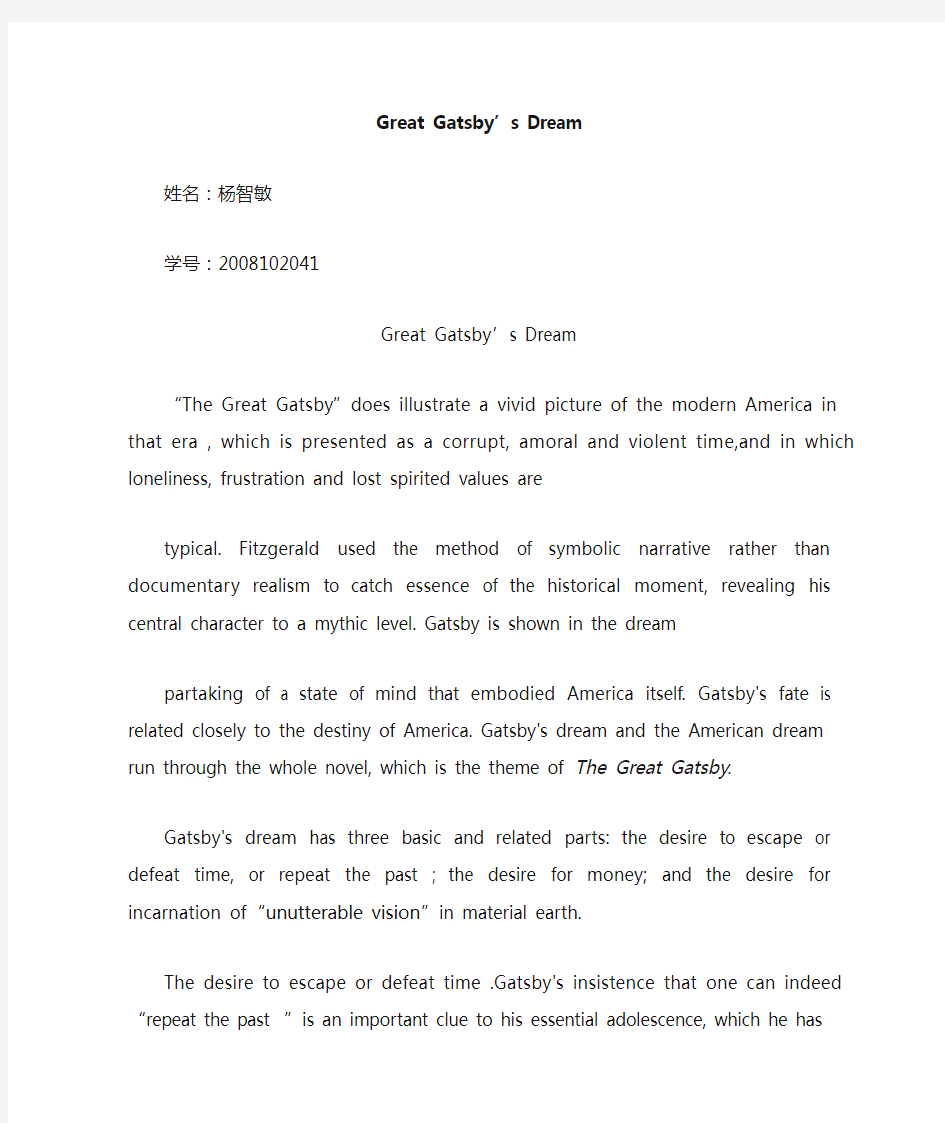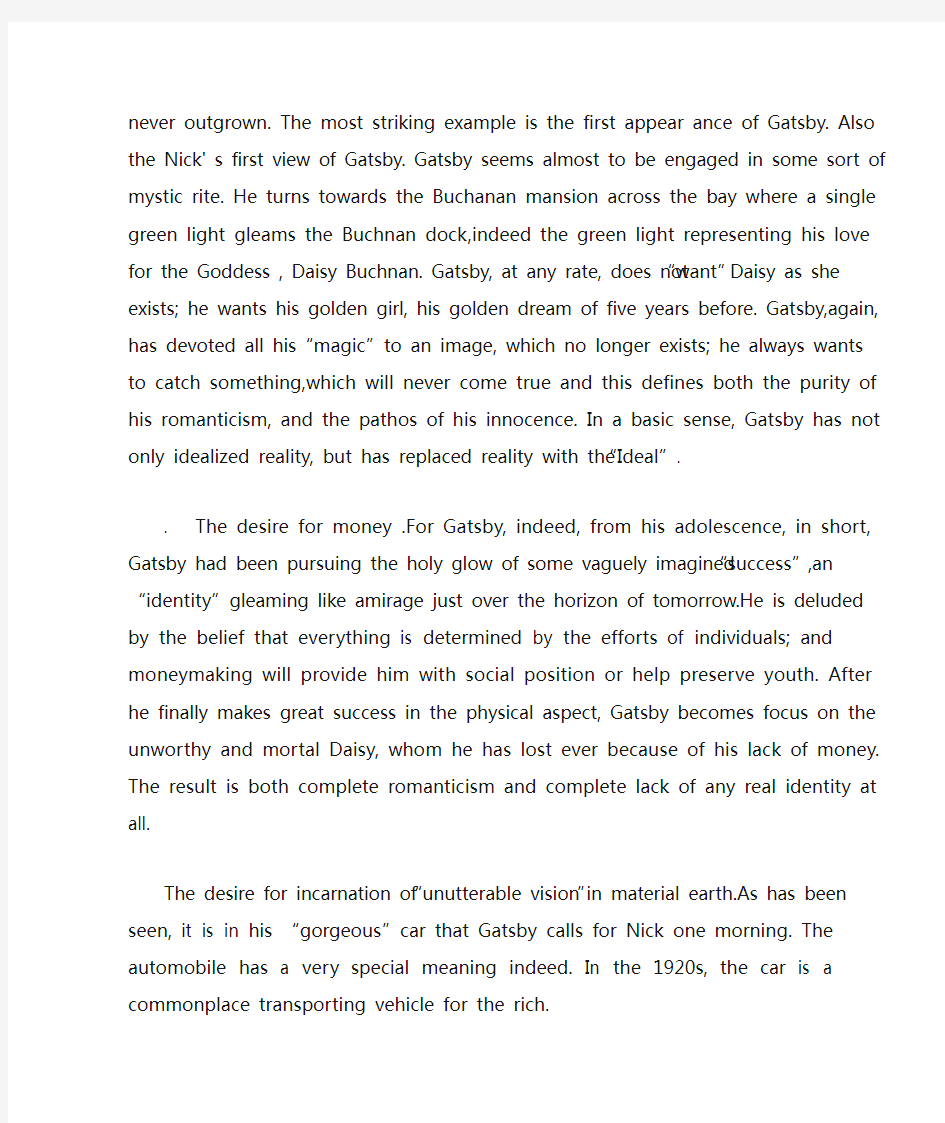伟大的盖茨比


Great Gatsby’s Dream
姓名:杨智敏
学号:2008102041
Great Gatsby’s Dream
“The Great Gatsby”does illustrate a vivid picture of the modern America in that era , which is presented as a corrupt, amoral and violent time,and in which loneliness, frustration and lost spirited values are typical. Fitzgerald used the method of symbolic narrative rather than documentary realism to catch essence of the historical moment, revealing his central character to a mythic level. Gatsby is shown in the dream partaking of a state of mind that embodied America itself. Gatsby's fate is related closely to the destiny of America. Gatsby's dream and the American dream run through the whole novel, which is the theme of The Great Gatsby.
Gatsby's dream has three basic and related parts: the desire to escape or defeat time, or repeat the past ; the desire for money; and the desire
for incarnation of“unutterable vision”in material earth.
The desire to escape or defeat time .Gatsby's insistence that one can indeed “repeat the past ”is an important clue to his essential adolescence, which he has never outgrown. The most striking example is the first appear ance of Gatsby. Also the Nick' s first view of Gatsby. Gatsby seems almost to be engaged in some sort of mystic rite. He turns towards the Buchanan mansion across the bay where a single green light gleams the Buchnan dock,indeed the green light representing his love for the Goddess , Daisy Buchnan. Gatsby, at any rate, does not “want”Daisy as she exists; he wants his golden girl, his golden dream of five years before. Gatsby,again, has devoted all his “magic”to an image, which no longer exists; he always wants to catch something,which will never come true and this defines both the purity of his romanticism, and the pathos of his innocence. In a basic sense, Gatsby has not only idealized reality, but has replaced reality with the “Ideal”.
. The desire for money .For Gatsby, indeed, from his adolescence, in short, Gatsby had been pursuing the holy glow of some vaguely imagined “success”,an “identity”gleaming like amirage just over the horizon of tomorrow.He is deluded by the belief that everything is determined by the efforts of individuals; and moneymaking will provide him with social position or help preserve youth. After he finally makes great success in the physical aspect, Gatsby becomes focus on the unworthy and mortal Daisy, whom he has lost ever because of his lack of money. The result is both complete romanticism and complete lack of any real identity at all.
The desire for incarnation of “unutterable vision”in material earth.As has been seen, it is in his “gorgeous”car that Gatsby calls for Nick one morning. The automobile has a very special meaning indeed. In the 1920s, the car is a commonplace transporting vehicle for the rich. As the identity of Gatsby's fortune and success, the automobile is
described with in interesting series of adjectives : “Everybody had seen it. It was a rich cr eam color , bright with nickel,swollen here and there in its monstrous length with triumphant hat boxes and supperboxes and toolboxes,and terraced with a labyrinth of windshields that mirrored a dozen suns. ”(1)The adjectives communicate a sense not only of opulence, but also of combined brittleness and softness, almost of decay.And Gatsby himself is emotionally infected with a perpetual restlessness, a kind of insistent disaffection or impatience. Whatever wealth has brought to Jay Gatsby, one thing is clear: it has brought him neither peace nor any real pleasure.Another typical example is Gatsby's magic shirts. “He took out a pile of shirts and began throwing them, one by one, before us, shirts of sheer linen and thick silk and fine flannel, which lost their folds as they fell and covered the table in many colored disarray. While we admir ed that he brought more and the soft rich heap mounted higher shirts with stripes and scrolls and plaids in coral and apple green and lavender and faint orange, with monograms of Indian blue. ”(2). He is not simply showing them the shirts. In the eyes of Gatsby, these shirts are important not in themselves, but for what they represent the shrine of“success”and Ideal value make possible by success itself. All of Gatsby's possessions are far more than a material object; they are a “sign”of the pathetic mystique which serves Gatsby the representative of“The American Dream”as he worships a kind of ultimate value that far transcends any material object at all. For Gatsby, the material object transcends itself; it becomes a mystic sign and spiritual endowment.
In depicting the rise and fall of Gatsby, Fitzger ald not only gives us an insight into the life and death of a romantic hero, but also an insight into the cultural dynamics of the twentieth century, showing that the dream of spiritual freedom is inseparable from that of material advancement. Romantic expectation, no matter how intensely conceived,
cannot function independently of social reality.
Reference: (1)(2) Francis Scott Key Fitzgerald ,The Great Gatsby. ShangHai Translation Press, 1982.
i
